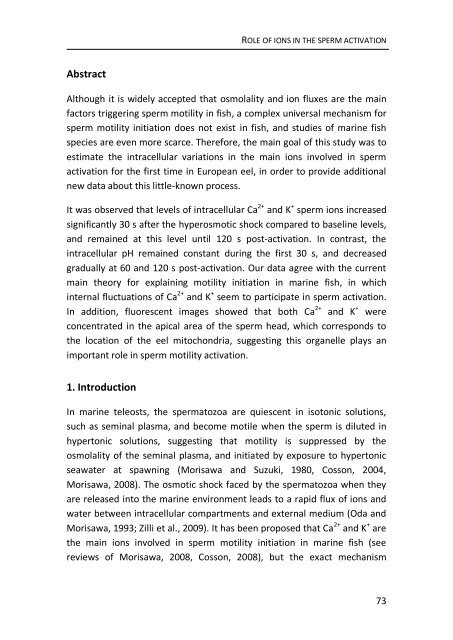chapter 3 - RiuNet
chapter 3 - RiuNet
chapter 3 - RiuNet
Create successful ePaper yourself
Turn your PDF publications into a flip-book with our unique Google optimized e-Paper software.
ROLE OF IONS IN THE SPERM ACTIVATION<br />
Abstract<br />
Although it is widely accepted that osmolality and ion fluxes are the main<br />
factors triggering sperm motility in fish, a complex universal mechanism for<br />
sperm motility initiation does not exist in fish, and studies of marine fish<br />
species are even more scarce. Therefore, the main goal of this study was to<br />
estimate the intracellular variations in the main ions involved in sperm<br />
activation for the first time in European eel, in order to provide additional<br />
new data about this little-known process.<br />
It was observed that levels of intracellular Ca 2+ and K + sperm ions increased<br />
significantly 30 s after the hyperosmotic shock compared to baseline levels,<br />
and remained at this level until 120 s post-activation. In contrast, the<br />
intracellular pH remained constant during the first 30 s, and decreased<br />
gradually at 60 and 120 s post-activation. Our data agree with the current<br />
main theory for explaining motility initiation in marine fish, in which<br />
internal fluctuations of Ca 2+ and K + seem to participate in sperm activation.<br />
In addition, fluorescent images showed that both Ca 2+ and K + were<br />
concentrated in the apical area of the sperm head, which corresponds to<br />
the location of the eel mitochondria, suggesting this organelle plays an<br />
important role in sperm motility activation.<br />
1. Introduction<br />
In marine teleosts, the spermatozoa are quiescent in isotonic solutions,<br />
such as seminal plasma, and become motile when the sperm is diluted in<br />
hypertonic solutions, suggesting that motility is suppressed by the<br />
osmolality of the seminal plasma, and initiated by exposure to hypertonic<br />
seawater at spawning (Morisawa and Suzuki, 1980, Cosson, 2004,<br />
Morisawa, 2008). The osmotic shock faced by the spermatozoa when they<br />
are released into the marine environment leads to a rapid flux of ions and<br />
water between intracellular compartments and external medium (Oda and<br />
Morisawa, 1993; Zilli et al., 2009). It has been proposed that Ca 2+ and K + are<br />
the main ions involved in sperm motility initiation in marine fish (see<br />
reviews of Morisawa, 2008, Cosson, 2008), but the exact mechanism<br />
73
















